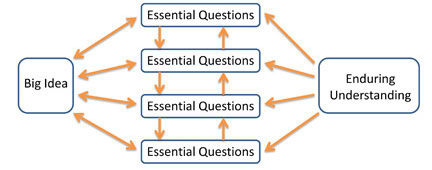What are Big Ideas and Essential Questions?
It goes without saying that a primary goal for your students is to develop understanding of science concepts that ensure well past the next test. The question is, what is the best way to achieve that goal?
Big Ideas
Big Ideas are generalizations—broad, powerful concepts that connect facts and events that may otherwise seem unrelated. Big Ideas are implicit understanding that help the world make sense. Big Ideas define the "folders," or units, of ScienceFusion. Each is a statement that articulates the overarching teaching and learning goals of a unit.
Essential Questions
Essential Questions define the "files," or information, in a unit. Each Essential Question identifies the conceptual focus of a lesson that contributes to your students' growing understanding of the associated Big Idea. As such, Essential Questions give your students a sense of direction and purpose.
With ScienceFusion, our goal is to provide you with a tool that helps you help your students develop Enduring Understandings in science. Our strategy for achieving that goal is to provide lesson plans with 5E-based learning experiences organized in a framework informed by schema theory.

Approach & Components
Why is ScienceFusion the best program for my student?
Program Design
As we designed ScienceFusion, we applied cutting-edge research to build new tools (eLearning Curriculum) and to overhaul more traditional ones (Write-In Student Edition).
More than technology or print materials, it's the way ScienceFusion meets the needs of today's students and teachers that makes it the next-generation science program. In your evaluation, consider the following questions and discover how ScienceFusion stands apart from other science programs.
What does 360° of Inquiry mean?
With ScienceFusion, every click, every page turn, every lab and activity is an everyday opportunity to ask questions, think critically, and make informed decisions.
- Stands apart from traditional programs that compartmentalize student learning
- Students develop inquiry skills, STEM (Science, Technology, Engineering, and Mathematics) skills, science concepts, and vocabulary through inquiry and application
- Engages students in the process of science on every page, in every digital lesson, and in every hands-on activity
Why is multi-modal learning important?
Traditional programs repeat the same content across multiple formats, but with ScienceFusion you get a full curriculum of digital and print lessons that are complementary.
- Provides a new learning experience with every lesson, lab, and investigation
- Makes it easier for you to teach and reinforce concepts
- Enables you to reach all learners in their unique learning style
What is the difference between traditional textbook and a write-in textbook?
Traditional textbooks assume students can read and comprehend content text. With ScienceFusion, the innovative magazine-style format makes science accessible to all learners.
- Provides opportunities to take notes, make sketches, and record data right in their textbook
- Departs from the traditional column layout with up-to-date research on how today's students learn
- Accommodates both left and right-brain learners with visuals designed to integrate with text
What is an eLearning Curriculum?
Learning in front of a laptop requires specific learning strategies. That's why ScienceFusion applies cutting-edge research into online learning and online classroom management.
- Delivers dynamic science lessons with more than 3000 videos, animations, simulations, and virtual labs
- Gives you 24/7 access to innovative digital lessons and virtual labs
- Enables you to introduce concepts and skills, provide interactivity and feedback, track, and assess—all from one platform
Discover the power of ScienceFusion’s 360° of inquiry to engage your 21st-century learner!
ScienceFusion offers a wealth of features found in no other program that will help your students develop science and technology skills they need. See them in action in this preview! For example:
- Highly engaging, interactive content—produced by lead author Marjorie Frank (you know her from Ranger Rick, Discovery Kids, and Weekly Reader!)—is developed at just the right level to reach students in every grade.
- Active learning approach gets students to think like scientists—they're asked to make connections, apply what they learn, and draw conclusions throughout every lesson.
- True eLearning curriculum and Online Teacher Edition help you create a multimodal 21st-century learning environment—for every lesson in the print edition there is a different, but complementary, digital lesson.
- Unique Virtual Labs and STEM-focused Video-Based Projects further engage students in the scientific method.
- Easy-to-access teaching support—discussion prompts, strategies, differentiation, and assessment tools—help you ensure that learning sticks!
View Video